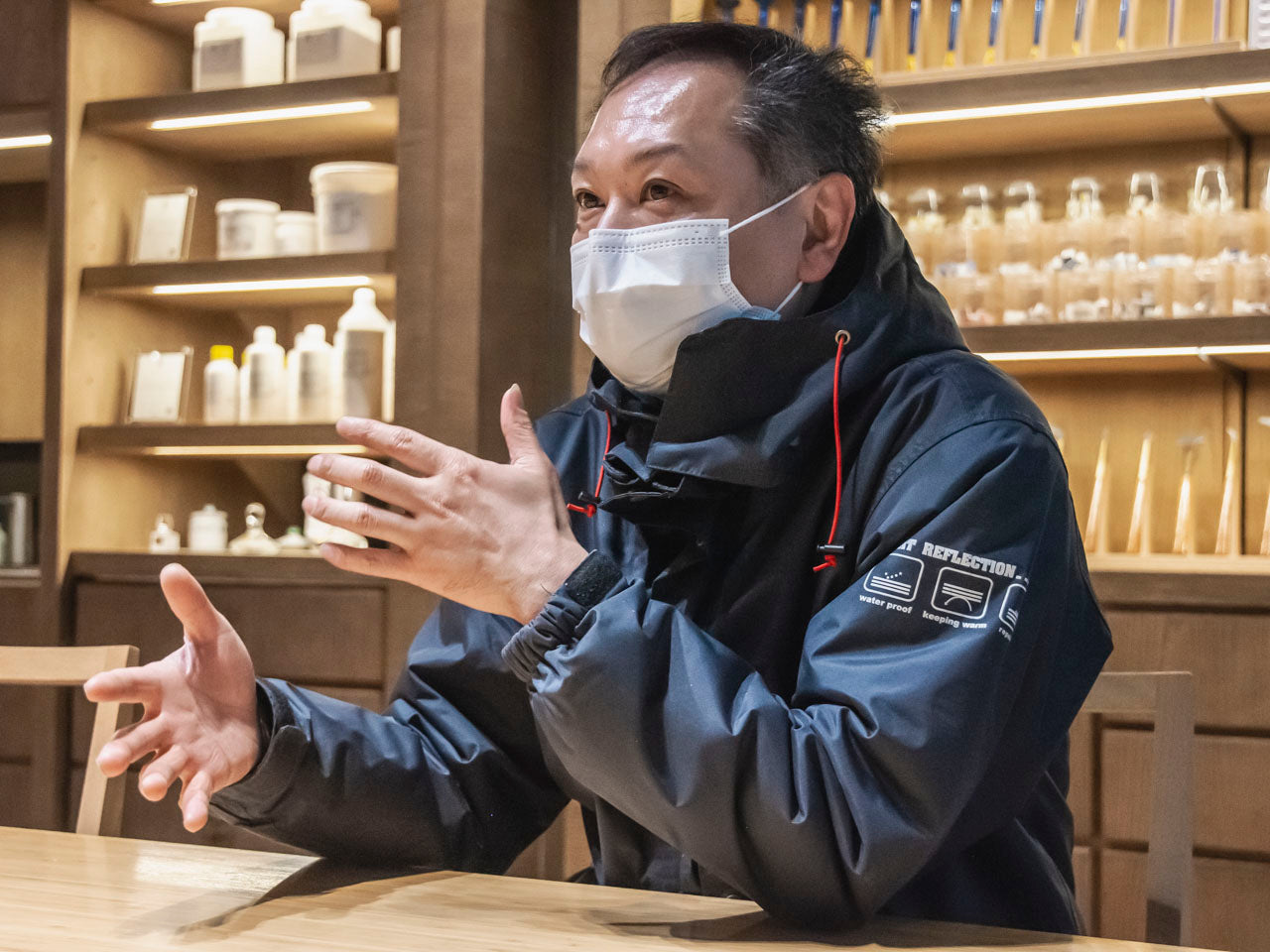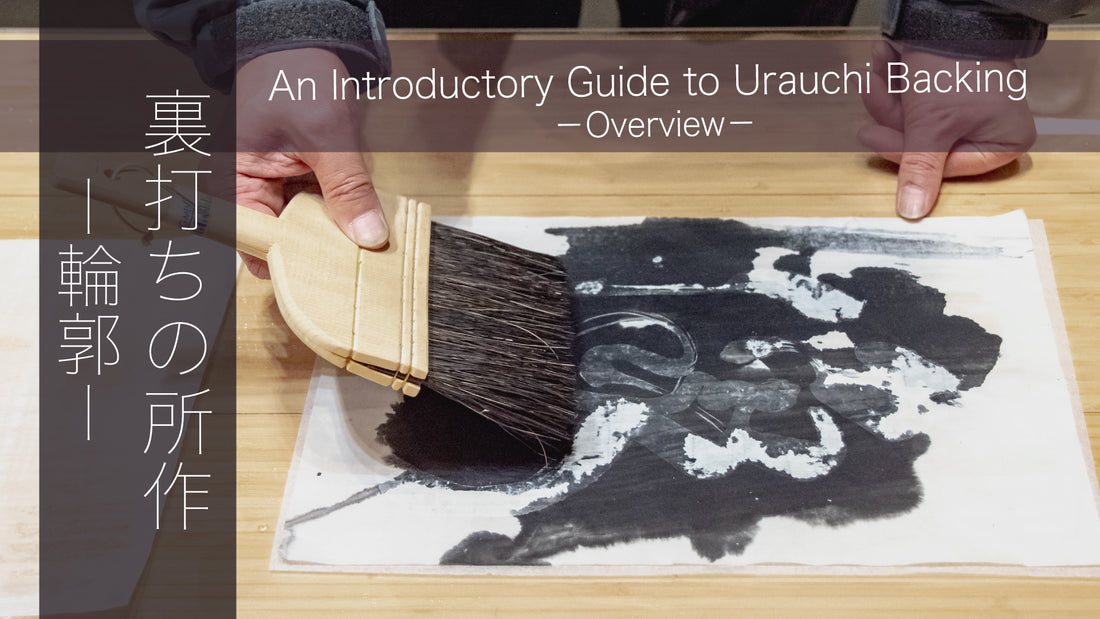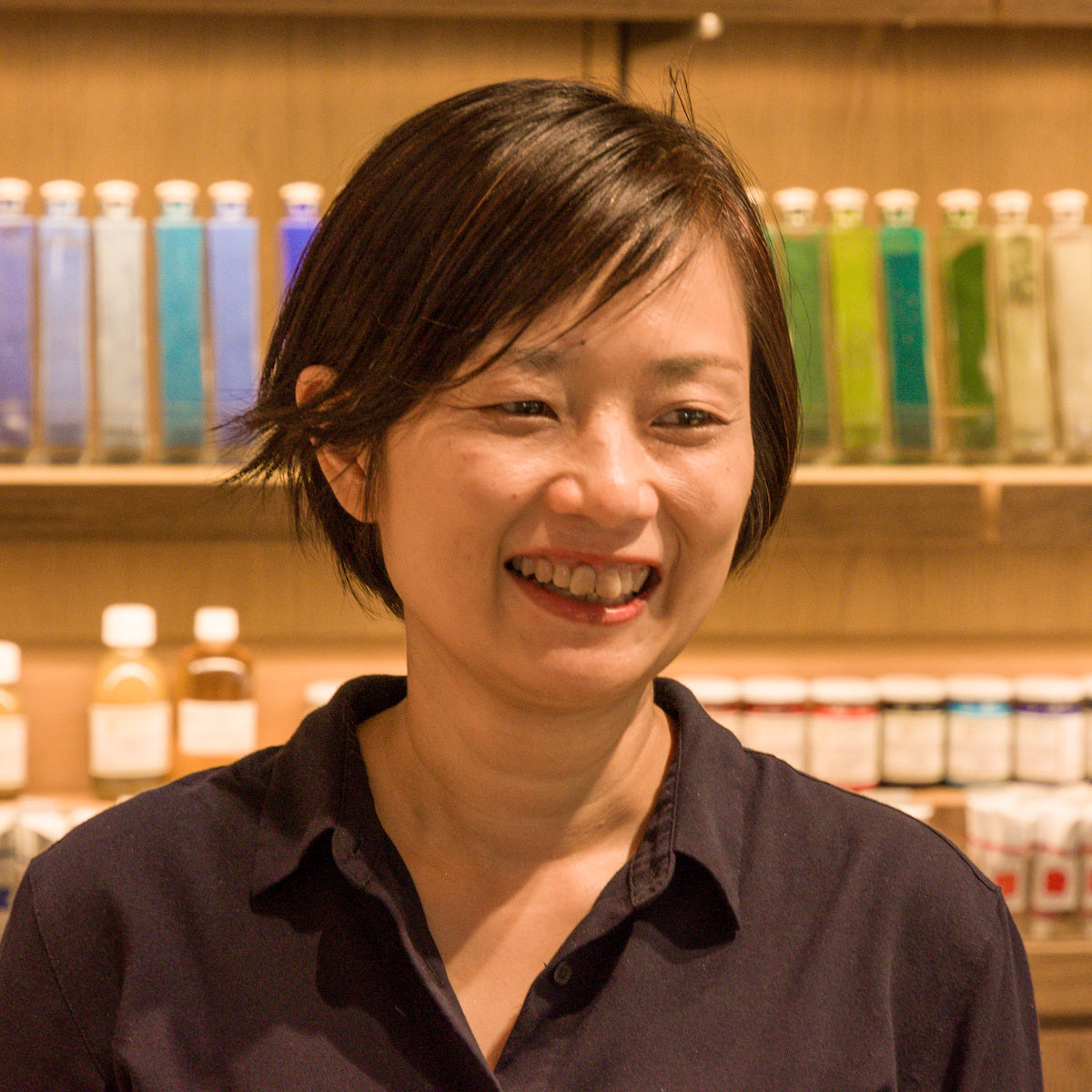Painting substrates, the cornerstone of painting, can be prepared in various techniques and forms depending on how the artists want it to be presented and displayed. As you may already know, no matter what material you choose, it is necessary to know its characteristics before working with it.
Although there are many ways to prep your paper, it also often requires some kind of crafting to support its thinness and fragility.
In this article, I will explain Urauchi Backing, a technique used for supporting paper and silk paintings.
The term "Hyougu" or "Hyousou" refers to the process of making traditional Japanese artworks such as hanging scrolls, scroll paintings, frames, sliding doors, folding screens, or partitions out of paper, silk, or decorated fabric.
Fun fact, the craftsmen who create these artworks are called "Hyougu-shi" in Japanese.
Urauchi is the first step in the process of Hyousou, and it is usually required for a piece of painting that is to be mounted on hanging scrolls and is a technique used to prevent paper or silk from being damaged or crumpled.
However, the tools and techniques required for this process are too complicated for non-professionals to do on their own, therefore, it is not easy to access the information and learn these techniques.
Luckily, in this article, we had an opportunity to interview Yasunori Monobe, a Hyougu-shi who also teaches workshops related to folding screens and other mounting techniques at PIGMENT TOKYO, and is involved in the restoration of cultural properties and historical artworks.

Mr. Yasunori Monobe
—Would you explain more about Urauchi? What kind of backing technique is it?Yasunori Monobe (hereafter Monobe / titles omitted):
It is the process of laminating and drying glued Washi paper on the back of another piece of paper or silk to strengthen the artwork.
The reason why paper needs to be Urauchi is that artwork on paper without any support often causes wrinkles and sagging on its surface, and that makes it less enjoyable for the viewers.
Urauchi is also for strengthening the paper by making it thicker and less prone to tearing.
—Urauchi is the technique generally used for reinforcement and restoration, but can it also be applied to other materials other than Washi paper and silk?
Monobe: We sometimes have Urauchi to restore Western paper. Other than that, you can apply this technique to woven, dyed textiles or thin cotton fabrics as well. However, it is difficult to do it for vinyl-type materials which repel glue.
—Did the technique of Hyousou (mounting) come to Japan from China?
Monobe : It is said that the origin of this technique is from ancient China along with Buddhism.
The four jewels of the study (inkstick, inkstone, brush, and paper) were a great invention for humankind. They made it possible to preserve information in written form and to pass on the knowledge of our predecessors to future generations.
People used to write Buddhist sutras on wood but after the invention of paper, people started writing sutras on scrolls because they keep a far greater volume of information than wood and can be carried around.
However, the paper was too thin and fragile to carry around constantly, so the Urauchi technique was born for preserving purposes.
Our ancestors have refined the techniques of Hyousou along with the context of materials development.
Therefore, although the techniques are originally from mainland China, the method and technique have changed throughout the history of Japan.
—What’s the difference between the Chinese and Japanese Urauchi techniques?
Monobe: Japanese Urauchi is also called Nage-Urauchi which means applying glue to the backing paper and lifting it.
This allows to glue the moistened art piece on top of wet paper and dry them together which helps for a precise finish look. This process is achievable thanks to the characteristics of the backing paper.
In Japan, mulberry paper (Kozo-shi) is used for the backing. This is because Japan was able to develop a strong paper that can be made with long fibers and is resistant to tearing even when moistened.
On the other hand, in mainland China, paper with short fibers such as Xuan paper (Sen-shi) is more commonly used. Therefore, the backing paper will tear once it’s moistened and lifted.
For this reason, the Urauchi method is prone to more errors because the dry paper is glued directly to the back of the artwork. That’s why it is also known as "Jigoku-uchi (hell backing)" in Japan.
The painting will sometimes wrinkle since the dry paper is placed on top of the glued and moistened area.
This does not make one better than the other, but it’s just a difference in materials and paper from region to region.
—Is there a minimum or maximum size, thickness, or weight limit for backing an artwork?
Monobe : There is no limitation.
We use multiple sheets of paper to Urauchi the large-size works.
However, if you are an amateur, the maximum possible size you can do Urauchi by yourself is about the size of an A4 paper (210 x 297 mm.)
Although we can have Urauchi with a large piece by slightly moving it bit by bit even under a small workspace, it is almost impossible for beginners to do so.
When we use more than one piece of Urauchi paper, the margin where papers overlap should be about 3.03 mm. Even though the overlap does not show because of how thin the paper is, if it is more than 3 mm, the scroll might bend and wrinkle when you try to roll it.
Therefore, it’s very important to stay focused while backing larger works.
In the case of hanging scrolls (Kakejiku), there are three processes called Hada-Urauchi, Mashi-Urauchi, and Sou-Urauchi to strengthen the paper and adjust its shrinkage.
—Are there any certain types of artwork that artists can do Urauchi on their own? Or is it better to leave it to the professionals?
Monobe: It depends on the purpose and technical skill of the artists even when they’re applying the Urauchi to their own artworks. I would say, if you intend to sell the art piece, it is better to ask a professional craftsman to do Urauchi for you.
—The shape of the brush differs between West and East Japan. Is there any main difference in usage?
Monobe: The usage is the same.
In Kyoto, the handle is rounded, while it’s mostly angular in the East.
—Is there any difference between Kyoto and other regions in terms of history and cultural background other than the tools?
Monobe: There is a difference in preference for the combination of fabrics used for decorating artworks.
For example, in Tokyo, the backing style is known as Edo Hyogu, created during the Edo period. The Tokugawa Shogunate (Military Government of Tokugawa) and many samurai families preferred gorgeous designs for their hanging scrolls, and back in the Edo period, local Japanese preferred decorative designs too.
On the other hand, Kyoto was a court noble culture, with the emperor as the head of the court, so people in Kyoto preferred more subdued designs. While Kyoto had been the capital of Japan longer than the Edo period, Hyogu-shi received many commissions from the imperial court, court nobles, shrines and temples, tea masters and samurai families.
As a result, it had long possessed advanced techniques and culture in the field of Hyosou.
It is truly a matter of supply and demand, the Hyougu-shi trained in Kyoto, then brought their skills back to their hometowns and passed these techniques to future generations. Therefore, in short, there are some quality differences depending on the region and the demands there.
That’s why I believe that the reason why Kyoto has more sophisticated and advanced craftsmanship is because of the higher demand for better quality Hyougu.
—So, the mastery of traditional techniques for restoration and Urauchi is important to maintain the beauty of the artwork for a long period of time.
Monobe: Exactly. Mastering the traditional techniques of Hyougu-shi takes about ten years of training and a lifetime of technical refinement. During the Hyougu process, a wide range of skills are required such as using a knife, saw, hand plane, needle, and thread, and cutting the braid of a folding screen at right angles.
Hyousou is to protect the artworks so they could last for a long time, some even are made to last for centuries. Another thing is that keeping the artwork in a condition that will be able to be repaired in the next generation is very important. That’s why we use not only the best techniques but also the best quality materials to preserve what is traditional and what our ancestors have done for us.
Our mission as a Hyougu-shi is to support and protect our protagonist (the artworks)!

Following is an explanation of the tools used for Urauchi.
◾️Tools and Materials:
・Mizubake (Water Brush)
・Noribake (Paste Brush)
・Nazebake (Smoothing Brush)
・Uchibake (Pounding/Pressing Brush) - for the use of backing silk
・Shoufu-nori (wheat starch glue or store-bought starch glue)
・Glue Sieve
・Wooden Basin (alternative: plastic or any kind of basin)
・Bowls
・Fine Mist Sprayer
・Water
・Hadaura-shi (mulberry/Kozo paper which thickness is about 3 momme/11.25g)
・Paper for Underlay - during the use of the Mizuhiki process
・Kakezashi / Kakebou (a long, thin stick or ruler used to lift up the Urauchi paper)
・Acrylic Board (waterproof board to cover a table for making it easier to work with)
Brushes for Urauchi are specially made in certain materials and shapes to suit the use of adjusting the amount of water and evenly spreading water and glue.
Different brushes have different purposes depending on the process of Urauchi.
◾️Brushes for Urauchi Technique (Used on Washi Paper and Silk)
A water brush is used for applying water.
The deer hair used for the Mizubake (water brush) has tiny holes on it, so the bristle can retain water well and does not drip after gently shaking the brush a few times to remove the excess water, but yet holding enough water to apply it on paper.

This is how the brush looks when it’s with plenty of water.
Since it is still dripping, the brush needs to be shaken 2 or 3 times to remove the excess water.
When a Mizubake brush is used for applying water, it creates strokes as the picture shows.
As with other animal hair brushes, if the brush is wet and the tip of the brush is placed facing up, water will accumulate at the base of the brush and cause damage. When in use, place the brush in a vertical position with the bristles facing down.
You may hang the brush on a rack to dry thoroughly.
Noribake (Paste Brush)
Noribake (Paste Brush) is used for applying thin layers of glue during the Urauchi process on Washi paper.
Especially the Daigokujo (best-quality) Noribake is very easy to handle glue and is highly recommended for those who are new to the Urauchi technique.
Tsukemawashi Brush
There is another type of glue brush with thicker and shorter bristles called Tsukemawashi Brush.
It is used for kneading glue and for thicker/harder glue.
After use, remember to wash the brush thoroughly with water so that no glue remains in the bristles.
You may soak it in a container filled with water for several hours to make it easier to remove all the glue. If glue is left on the brush, the bristle will harden after drying, in this case, simply repeat the above process so you can clean the glue off the brush.
After washing, dry the brush on a rack or hang it on a wall, just as you do with the Mizubake brush.
◾ Brushes for Applying Urauchi on Washi Paper
The Tsugu (palm) fiber used for Tsugu Nazebake (Smoothing Brush) is hard and firm which makes it suitable for Urauchi.
After use, it needs to be wiped off the glue with a wet rag.
On the other hand, the Nazebake brush made with goat hair is soft and smooth, and is used for flattening the surface of the paper.
◾Tools for Applying Urauchi on Silk
Uchibake (Pounding/Presshing Brush)
Uchibake (Pounding/Pressing Brush) is used for backing silk and fabric.
Its thick bristle allows us to repeatedly pound the materials to glue them together.
Same as with the Tsugu Nazebake, wiping the glue off with a wet rag after use is necessary.
Please try to avoid washing it with water.
◾Glue
Glue paste is necessary for both Washi paper and silk Urauchi backing.
In the original method, Shofu-nori is commonly used to make glue by cooking it.
However, if you find cooking and straining the glue too difficult and time-consuming, you can use store-bought starch glue as an alternative. Another important thing, please note that if the adhesive contains ingredients such as acrylic or gum arabic, it will not be able to peel off easily even after moisturizing it, so it means that you will not be able to rework the art piece.
Both handmade and store-bought types of glue have high adhesive strength, so they have to be diluted with water to obtain the right consistency.
From now on, I would like to share the process of Urauchi, starting with diluting the glue.
◾️Preparation of Glue
【Thick Glue / For Silk】

① Knead the gel-like glue with a brush until it becomes soft.

② Add a small amount of water to the glue and knead well to avoid lumps from the bottom of the container.

③ The mixture is ready when it reaches a yogurt-like consistency.
【Fluid Glue / For Washi Paper】

① Add water to the above glue mixture and gradually stir it.
② When the liquid becomes as thin as rice water, fluid-type glue is ready to use.
If lumps form during the mixing process, simply filter the glue with the sieve.
The mesh part of this specialized glue sieve is made of horsehair so it is really hard to obtain these days, although a store-bought sieve made of nylon mesh can be used as an alternative.
If there’s only coarse mesh or you couldn’t find the right sieve, you can use a thin cloth such as gauze to filter the glue.
I do not recommend a metal mesh because it may contain metal powder or other contaminants.
Horsehair Glue Sieve (right in the image)
After all the preparation, I hope you will once again realize that the method of Urauchi backing, nurtured and cultivated by the climate and culture of Japan, may make works of art shine more beautifully for a longer time.
Furthermore, we can appreciate the craftsmanship that contains experiences and pearls of wisdom from the brushes and tools made with knowledge of the materials' characteristics.
I will continue introducing the Urauchi method for Japanese paper and silk in the upcoming article.
Monobe Yasunori / 物部 泰典
Traditional Craftsman of "Kyo-Hyogu" designated by the Minister of Economy, Trade and Industry
Representative Director, Monobe Gasendo Co.
Faculty at Kyoto University of Arts
Monobe Gasendo Co.
Monobe Gasendo was established in Kyoto in 1901, and has passed down the traditional techniques to four generations of Hyogu-shi.
Reference
“Encyclopedia of Hyougu” Kyoto Housogu Kyokai (ed.) (Kyo-Hyogu Cooperative Association 2011)
Translated by Atsumi Okano
PIGMENT TOKYO Art Materials Expert









